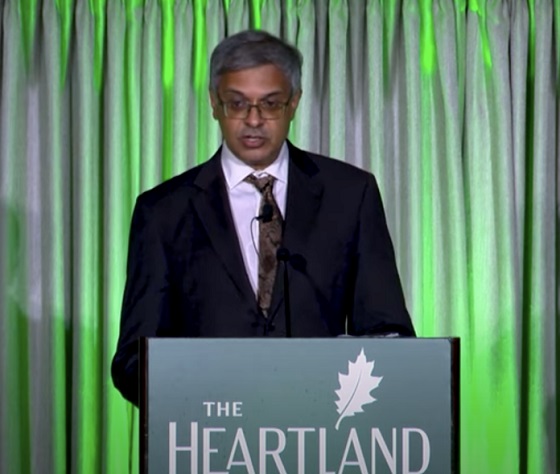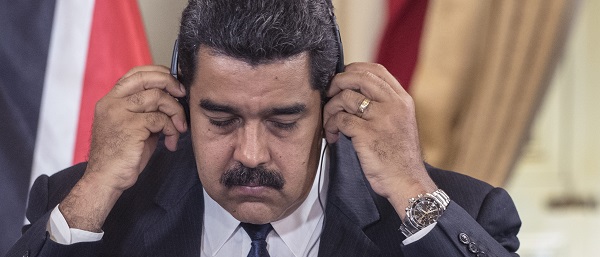Censorship Industrial Complex
‘Silicon Curtain’ Is Protecting Government Censorship

From Heartland Daily News
By AnneMarie Schieber
Citing Winston Churchill’s “Iron Curtain” metaphor describing the Cold War division of Europe, health care policy expert Dr. Jay Bhattacharya told an audience, “We are now in the middle of a Silicon Curtain of censorship descending across the previously free West.”
In a keynote address at The Heartland Institute’s Benefit Dinner in Chicago on September 13, Bhattacharya said public health is the new “fig leaf” for justifying government censorship.
“Free speech is in dire danger in the U.S.,” said Bhattacharya. “The government will use its power to suppress criticism [of] its own misinformation.”
Bhattacharya is a plaintiff in Murthy v. Missouri, in which the Supreme Court lifted a preliminary injunction directing the Biden administration not to “coerce or significantly encourage social-media companies to suppress protected speech” and remanded the case to a lower court.
“This gives a way to the government to censor at will,” said Bhattacharya. “All they have to do is send emails and algorithms to social media companies without naming a single person—just name ideas not allowed to be said online.
“The First Amendment, in effect, is an unenforceable dead letter,” said Bhattacharya.
Under Fire for Opinions
Bhattacharya, a medical doctor and professor of medicine, economics, and health care research policy at Stanford University, rose to prominence when he published The Great Barrington Declaration (GBD) on October 4, 2020, with epidemiologists Martin Kulldorff and Sunetra Gupta. The declaration criticized COVID lockdowns and urged authorities to focus on keeping children in school and protecting the elderly instead of imposing broad-based restrictions.
Although the writers were highly recognized for their work and associated with Stanford, Harvard, and Oxford Universities, respectively, powerful government figures denounced them. Francis Collins, then director of the National Institutes of Health, and Anthony Fauci, then director of the National Institute of Allergy and Infectious Diseases, called the trio “fringe epidemiologists” in emails that were made public later.
Ostracized and Blacklisted
Bhattacharya was ostracized by other professors at Stanford and was blacklisted on Twitter. When Elon Musk purchased the social media giant, he discovered the list and shared it with Bhattacharya.
Google “de-boosted” the GBD, which was posted online and signed by more than 940,000 doctors, researchers, and concerned citizens. Facebook banned posting of it altogether.
Using internal government emails they obtained, the plaintiffs showed the government was controlling social media companies by threatening to regulate them out of business if they didn’t abide by the Biden administration’s censorship demands.
The White House also used universities to help with the censorship work, which the government is prohibited from doing directly. Bhattacharya brought up the case of the Stanford Internet Observatory, which received government grants to develop algorithms to target a particular idea. The government shared that information with social media platforms.
Rising Worldwide
Europe, Canada, the U.K., and Australia have led the way on legislation to control speech, Bhattacharya told the audience. The bills and laws ostensibly outlaw violence, pornography, and hate on the internet, carry Orwellian names, and establish authorities to do the enforcement.
These include the Digital Services Act in the E.U., the Online Harms Act in Canada, and the Online Safety Act of 2023 in the U.K. A bill in France establishes a digital “safety” commission for the same purpose.
“It is dangerous to let governments have control over the definition of hate,” said Bhattacharya. “It’s even more dangerous to allow government to determine what is misinformation because science and medicine depend on free speech to operate properly.”
Censoring Political Opponents
Scott Jensen, a medical doctor and Minnesota state senator who ran against Tim Walz for governor in 2022, says his respect for Bhattacharya is immense. Jensen was a prominent critic of COVID-19 policies, and Facebook censored his election page. Jensen lost the race, and Walz went on to implement some of the most draconian COVID-19 restrictions and is Vice President Kamala Harris’s running mate in this year’s election for president.
“Dr. Bhattacharya’s willingness to present and stand by a contrarian narrative—which ultimately proved to be profoundly wise—will go down in history as an act of immense courage in the face of smothering government censorship fueled by behemoth, profit-driven technological companies,” said Jensen.
“American’s First Amendment rights are under attack by a political elite, but Dr. Jay Bhattacharya continues to stand in the breach and do whatever is necessary to protect and defend free speech,” said Jensen.
AnneMarie Schieber ([email protected]) is the managing editor of Health Care News.
Censorship Industrial Complex
US Under Secretary of State Slams UK and EU Over Online Speech Regulation, Announces Release of Files on Past Censorship Efforts

Sarah Rogers’ comments draw a new line in the sand between America’s First Amendment and Europe’s tightening grip on online speech.
|
|
Censorship Industrial Complex
Canadian university censors free speech advocate who spoke out against Indigenous ‘mass grave’ hoax

From LifeSiteNews
Dr. Frances Widdowson was arrested and given a ticket at the University of Victoria campus after trying to engage in conversation about ‘the disputed claims of unmarked graves in Kamloops.’
A Canadian academic who spoke out against claims there are mass unmarked graves of kids on former Indigenous residential schools, and who was arrested on a university campus as a result for trespassing, is fighting back with the help of a top constitutional group.
Dr. Frances Widdowson was arrested and given a ticket on December 2, 2025, at the University of Victoria (UVic) campus after trying to engage in conversation about “the disputed claims of unmarked graves in Kamloops,” noted the Justice Centre for Constitutional Freedoms (JCCF) in a recent news release.
According to the JCCF, Widdowson was trying to initiate a “good faith” conversation with people on campus, along with the leader of OneBC provincial party, Dallas Brodi.
“My arrest at the University of Victoria is an indication of an institution that is completely unmoored from its academic purpose,” said Widdowson in a statement made available to LifeSiteNews.
She added that the “institution” has been “perpetuating the falsehood” of the remains of 215 children “being confirmed at Kamloops since 2021, and is intent on censoring any correction of this claim.”
“This should be of concern for everyone who believes that universities should be places of open inquiry and critical thinking, not propaganda and indoctrination,” she added.
UVic had the day before Widdowson’s arrest warned on its website that those in favor of free speech were “not permitted to attend UVic property for the purpose of speaking publicly.”
Despite the warning, Widdowson, when she came to campus, was met with some “100 aggressive protesters assembled where she intended to speak at Petch Fountain,” noted the JCCF.
The protesters consisted of self-identified Communists, along with Antifa-aligned people and Hamas supporters.
When Widdowson was confronted by university security, along with local police, she was served with a trespass notice.
“When she declined to leave, she was arrested, detained for about two hours, and charged under British Columbia’s Trespass Act—an offence punishable by fines up to $2,000 or up to six months’ imprisonment,” said the JCCF.
According to Constitutional lawyer Glenn Blackett, UVic actions are shameful, as it “receives hundreds of millions of taxpayer dollars annually while it facilitates the arrest of Canadians attempting to engage in free inquiry on campus.”
Widdowson’s legal team, with the help of the JCCF, will be defending her ticket to protect her “Charter-protected freedoms of expression and peaceful assembly.”
Widdowson served as a tenured professor at Mount Royal University in Calgary, Alberta, before she was fired over criticism of her views on identity politics and Indigenous policy, notes the JCCF. She was vindicated, however, as an arbitrator later found her termination was wrongful.
In 2021 and 2022, the mainstream media ran with inflammatory and dubious claims that hundreds of children were buried and disregarded by Catholic priests and nuns who ran some Canadian residential schools. The reality is, after four years, there have been no mass graves discovered at residential schools.
However, as the claims went unfounded, over 120 churches, most of them Catholic and many of them on Indigenous lands that serve the local population, have been burned to the ground, vandalized, or defiled in Canada since the spring of 2021.
Last year, retired Manitoba judge Brian Giesbrecht said Canadians are being “deliberately deceived by their own government” after blasting the former Trudeau government for “actively pursuing” a policy that blames the Catholic Church for the unfounded “deaths and secret burials” of Indigenous children.
As reported by LifeSiteNews, new private members’ Bill C-254, “An Act To Amend The Criminal Code” introduced by New Democrat MP Leah Gazan, looks to give jail time to people who engage in so-called “Denialism.” The bill would look to jail those who question the media and government narrative surrounding Canada’s “Indian Residential School system” that there are mass graves despite no evidence to support this claim.
-

 Environment1 day ago
Environment1 day agoLeft-wing terrorists sabotage German power plant, causing massive power outage
-

 Daily Caller1 day ago
Daily Caller1 day agoMinnesota Governor resigns from re-election campaign as massive government frauds revealed
-

 International18 hours ago
International18 hours agoPoilievre, Carney show support for Maduro capture as NDP’s interim leader denounces it
-

 Energy1 day ago
Energy1 day agoTrump’s Venezuela Move: A $17 Trillion Reset of Global Geopolitics and a Pivotal Shift in US Energy Strategy
-

 International24 hours ago
International24 hours agoMaduro, wife plead not guilty in first court appearance
-

 Frontier Centre for Public Policy1 day ago
Frontier Centre for Public Policy1 day agoIs Canada still worth the sacrifice for immigrants?
-

 Bruce Dowbiggin1 day ago
Bruce Dowbiggin1 day agoThe Olympic Shutout: No Quebec Players Invited For Canada
-

 Education1 day ago
Education1 day agoMother petitions Supreme Court after school hid daughter’s ‘gender transition’




